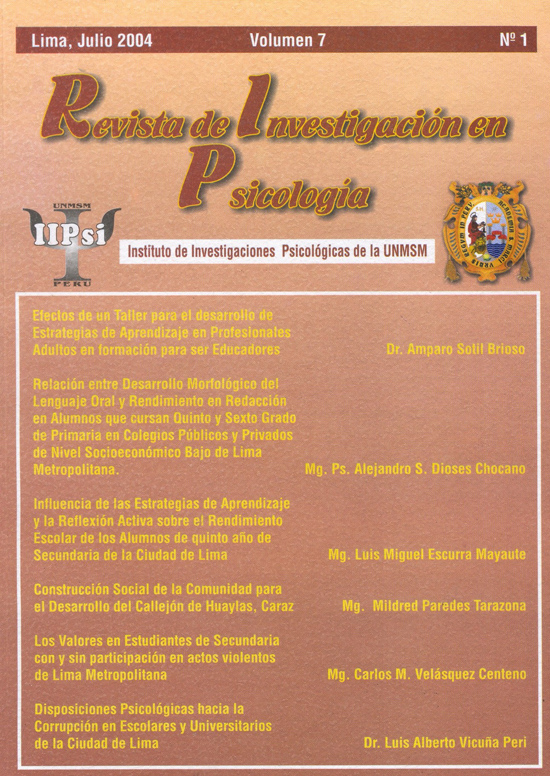Influences of the strategies of learning and the active reflectlon on the scholastlc yleld of the students of flfth year of secondary of the city of Lima
DOI:
https://doi.org/10.15381/rinvp.v7i1.5138Keywords:
learning strategies, active reflection, academic performance, high school students, structural equation modelingAbstract
OBJECTIVE: To determine the influence of learning strategies and the active reflection on the academic performance of senior high school students of the city of Lima. DESIGN: Multivariate correlational study carried on Lima and Callao high school students of the 2003 class. INSTRUMENTS AND METHODS: A two stages conglomerate sampling afixed to size was used, resulting 1200 adolescents as participants. The ACRA scale was used and an Active Reflection scale was elaborated. The statistics analysis was done in three stages: A psychometric analysis to evaluate validity and reliability of ACRA's and Active Reflection scales, a descriptive analysis of the studied variables, and a multivariate (structural equation modeling) and bivariate analysis to test the hiphotesis. RESUL TS: The adolescents mean age was 16.1 year (with.±. 0.86 error aproximation). The 52% were female and the 48% were male. The students from public schools were the 53.8% and the ones from private schools were the 46.2%. Those from Lima were 61.1 %. CONCLUSIONS: The results indicated that both instruments, ACRA's and Active Reflection scales are valid and reliable. The students scores in both ACRA's and Active Reflection scales, and academic performance are normally distributed. There are significative differences in learning strategies and active reflection when each variable is analized considering school management. There are significative differences both in learning strategies and active reflection considering gender, also learning strategies and active reflection afects positively academic performance.Downloads
Published
Issue
Section
License
Copyright (c) 2004 Luis Miguel Escurra Mayaute, Ana Delgado Vásquez, Amparo Sotil Brioso, Juan Pequeña Constantino, Rosario Quezada Murillo, Gerardo Rivas Castro, Rolando Solis Narro, Julio Santos Islas

This work is licensed under a Creative Commons Attribution-NonCommercial-ShareAlike 4.0 International License.
THE AUTHORS RETAIN THEIR RIGHTS:
a. The authors retain their trademark and patent rights, and also on any process or procedure described in the article.
b. The authors retain the right to share, copy, distribute, execute and publicly communicate the article published in the Journal of Research in Psychology (for example, place it in an institutional repository or publish it in a book), with acknowledgment of its initial publication in the Journal of Research in Psychology.
c. Authors retain the right to make a subsequent publication of their work, to use the article or any part of it (for example: a compilation of their work, lecture notes, thesis, or for a book), provided that they indicate the source. of publication (authors of the work, magazine, volume, number and date).






